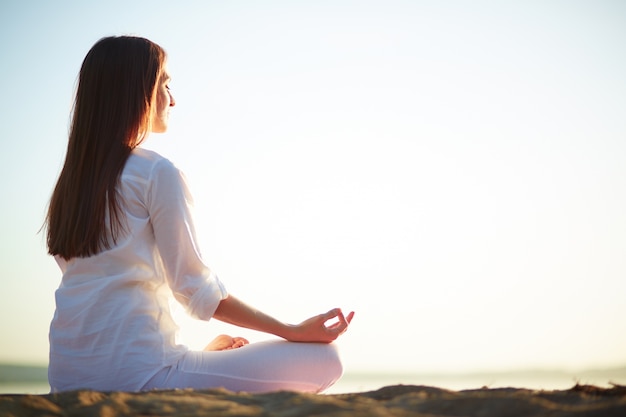Anxiety and Meditation
Anxiety and Meditation
Alright, I'll confess. I've been a little lax about meditating this past summer. As in I've only visited the practice twice. Solely because summer doesn't boast as many hassles as the rest of the year. Then again that statement may only be true for me. Regardless, with school starting it's definitely time to for me to resume my use of the discipline. For those of you who are entirely new to meditation what better time to start than the portion of the year most laden with stress?
There are many different ways to meditate so if you're not the type of person who has abundant spare time don't assume that it's not for you. If you can manage to clear your mind for a few minutes every day that's excellent. Just ensure that it's on your own time and not halfway through math class. For some, a dimly lit space with minimal noise works magic, whereas others can find peace in chaotic environments. Before I open the door to serenity I would like to provide some background information in terms of how meditation originated.
As far as written records go, meditation (Dhyana) appears to date back to 1500 BCE in Medieval/Early Modern India. It was practiced by Advaita Vedantins who were on the path towards spiritual enlightenment. Meditation was one of the principle teachings of Advaita Vedanta. Towards the 5th and 6th centuries BCE, Buddhist India and Taoist China adopted meditation and made it their own. Buddhism traveled to Han China by way of the silk road around 2nd century CE. Meditation is also present in other religions such as Jainism, Judaism, and Christianity but is not as popular as it has always been in Middle Eastern and Asian culture.
Meditation has made a place for itself in modern society and is now accepted widely. People practice it, research it, and are developing apps to make it more accessible as I demonstrated in my previous blog. Although meditation is considered one of the most important steps towards spiritual enlightenment, zen, nirvana, etc. you do not have to be a follower of any particular God or faith to reap its benefits. The reason why it's been a part of mainstream culture since the mid twentieth century is that virtually anyone can be a party to it.
How do I get started?
There isn't one select way to meditate. In fact I try to change up my sessions as much as I can and the reason for this is twofold. I learn more about what helps me clear my mind and I also don't begin to think of meditation as a tedious daily ritual. It should not be something you feel obligated to do but rather something you look forward to after a demanding day. So I encourage you to do the same. Take bits and pieces from what you read online and videos on YouTube and put together your own custom meditations.
Of course the most important part of meditating is clearing your head. Easier said than done. Some days you just can't seem to block out all the noise. Here's a step by step guide of what usually helps me banish my thoughts and what I feel will help the majority of you do so as well. Feel free to ignore some steps and add in your own so your meditation is tailored to you.
1. Create an ideal atmosphere. I say ideal because everyone's utopia varies. Generally, create a space that you would feel comfortable spending a couple of minutes in without feeling the need to get up and adjust something. Some factors you might want to keep in mind are temperature, noise levels, lighting, how clean the area is, and other objects you think would improve your experience. A scented candle can be a great addition to your space and its ambience. Clear the vicinity of any fire hazards if you feel like trying that one out. I went camping this summer and found that a great place to meditate was actually inside my tent. I felt more connected with nature and didn't require any beats.
2. Taking a warm shower or bath. Choose whichever you prefer and/or have time for. Baths are fairly time consuming so if you have a busy schedule I'd suggest you shower instead. You know what else baths consume a lot of? Water. Do Mother Nature a favour and skip the bonding time with your rubber ducky if possible.
3. Drinking a glass of warm milk or herbal tea. Chamomile boosts glycine levels which relaxes nerves and makes you feel more tired. Same with warm milk. If you know you would feel too sluggish to meditate afterwards then I'd recommend you skip this step.
4. Changing into simple, comfortable clothes. If you find yourself in an outfit predominantly made of polyester it might help to change into something more relaxed such as a cotton blend. Think what you wear to sleep and to hit the gym.
5. Playing Binaural Beats. Search for videos that use sounds you find soothing. If you are ever able to quiet your mind to an exceptional degree you won't even notice the beats playing in the background until you come out of your meditative state. The beats will generate one of the states either alpha, theta, or gamma.
6. Experimenting with different positions. When are you most comfortable? Perhaps it's sitting cross-legged, lying on your back, sitting in a chair, or folded into an origami swan. Whatever works for you.
7. Focusing on your breathing. There are many different ways to breathe when meditating but I find that I prefer this pattern as I've been using it since I started. It's called 4-7-8 breathing. Basically you are inhaling through the nose for a count of 4, holding your breath for 7 counts, and exhaling through the mouth for 8. It's fairly simple and easy to slip into a rythm.
8. Once you've mastered the breathing pattern of your choice you can begin doing a full body scan. Essentially you're doing a head to toe assessment of the tension you're storing. This is a great way to connect your mind and body. Contract each part of your body and release slowly to eliminate tension .
9. A lot of people like to stop here and simply continue with breathing. If you'd like to go the extra mile you can focus on a particular memory, location, person, or object that makes you feel at peace. As I mentioned before I like to switch up my meditations so I might picture myself in a meadow one day and paragliding the next. I also enjoy envisioning entire scenes so not only am I in the meadow I'm picking flowers and climbing trees as well.
Congratulate yourself on a successful session. It's the first step on the path to achieving peace of mind. Next week I will cover more on meditation as there are a deluge of subcategories to address. My next post will focus more on traditional techniques.










Wow Bhavya....Great article and well researched. I am really happy and surprised that you choose this topic and you do it yourself. Keep it up.
ReplyDeleteImpressive!! Keep it coming my dear! All the best!
ReplyDeleteWow I didn't know about binaural beats....definitely gonna give that a try.
ReplyDeleteCheers!
Sid
Well written Bhavya! Shall wait for the next post!
ReplyDeleteKavita S
I enjoyed your blog immensely. Looking forward to sharing it and reading more:) You're an inspiration!
ReplyDelete